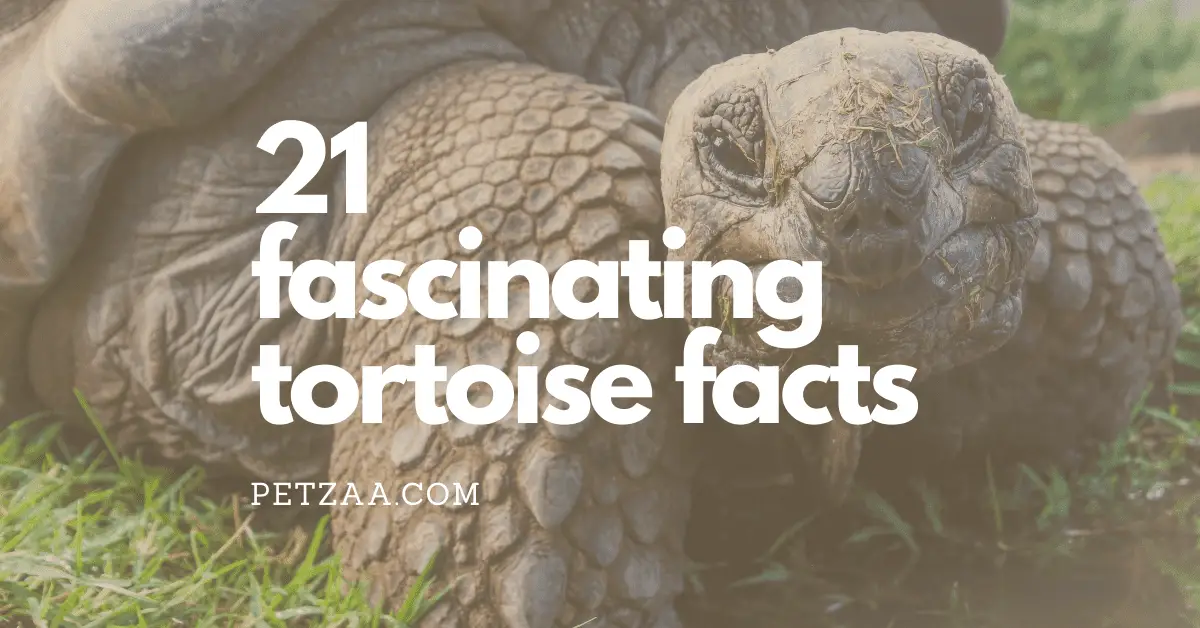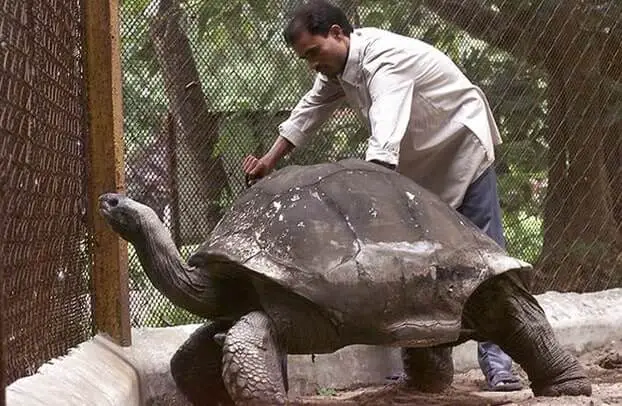21 Fascinating Tortoise Statistics & Facts
Tortoises are some of the oldest, longest living animals on earth today.
They come in many sizes and colors and are like modern day dinosaurs.
You are about to learn 21 cool, fascinating facts about tortoises. Use them for your homework, to impress your friends or simply to learn more about the wonderful world of tortoises.

How much do you know about tortoises? Let’s find out together.
1. The oldest tortoise reportedly lived 255 years

An incredible story from India.
Robert Clive, a British General, reportedly received four tortoises in 1757 as a gift following a military victory. All but one tortoise died.
The living tortoise was named Adwaita.
In 2006, Adwaita died at the Alipore Zoological Gardens of Kolkata, India.
Adwaita’s shell cracked and an infection developed. A few months later, Adwaita passed away due to liver complications.
The tortoise lifespan varies by species but averages 80-125 years.
Let’s think about this for a moment. Adwaita was alive for the following historical events:
- 1759 – French and Indian War
- 1769-1770 – James Cook’s exploration of Australia and New Zealand
- 1773 – Boston Tea Party
- 1776 – Declaration of Independence in the United States of America
- 1789-1799 – The French Revolution
- 1798 – The Irish Rebellion
- 1837 – Charles Dickens publishes Oliver Twist
- 1859 – Charles Darwin publishes On the Origin of Species
- 1879 – Thomas Edison tests his first light bulb
- 1969 – First U.S. landing on the moon
- 2006 – U.S. President was George W. Bush
That’s crazy to think about.
2. The smallest tortoise species is the padloper

Source: https://commons.wikimedia.org/wiki/File:Homopus_areolatus_-Common_Padloper-_Cape_Town.jpg
When we think about tortoises, the giant Aldabra and Galapagos tortoises probably come to mind. But, tortoises come in all sizes.
The smallest tortoise species is the padlopers (Homopus).
Padlopers originate in southern Africa, with shell lengths of 4 to 6 inches (10 to 15 cm)
3. The largest tortoise species are the giant tortoise
Yes, tortoises can get big!
The largest tortoise species are the giant tortoises (Geochelone) of the Aldabra and Galapagos islands.
Giant tortoise shells can grow to over 3.3 feet (1 meter) long and they can be over 5 feet (1.52 m) tall.
4. Tortoises have the capacity for long term memory
Tortoise not only live a long time, but new research is also confirming their capacity for long-term memory.
Researchers taught tortoises to pick colored targets. 9 years later, they tested the tortoises again. The tortoise remembered much of their training. Crazy!
Can you imagine what George, the 100-year-old giant Aldabra tortoise housed at the Vienna Zoo, can remember?
5. Charles Darwin collected a tortoise that lived until 2006
Having been collected by Charles Darwin himself, Harriet was a Galapagos giant tortoise (Chelonoidis porteri) born in 1830.
Darwin’s friend, John Wickham, brought her to Australia in 1842 for a warmer climate.
She lived the last 20 years of her life at Australia Zoo with the Irwin family. What a gal!
Given the difficulty in dating animals older than 100 years, some scientists believe that there are tortoises alive that are hundreds of years old. Wowzers!
6. Tortoises are native to all continents except Antarctica and Australia
That’s right. Tortoises are native most of the world’s continents.
Antarctica is not suitable for any tortoise species due to the extreme cold. Tortoises are reptiles and you don’t find reptiles in Antarctica. Brrrrrrr…
Now, you can find tortoises in Australia today, but they were brought by explorers and British generals. None are native.
It makes you wonder why? Australia is home to many reptiles. Hmmmm…
7. All tortoises are turtles, but turtles are not tortoises
When we think about tortoise characteristics, we think about the shell and legs. But how is that different than a turtle?
A turtle includes any shelled reptile belonging to the animal order Chelonii. A tortoise is a more specific term, referring to terrestrial turtles.
Almost all tortoises are herbivores and are unable to swim.
So, how can you tell them apart?
First, look at their feet and their shells.
Water turtles have webbed feet, individual “fingers,” and longer claws, along with flatter shells. Most turtles can swim.
On the other hand, tortoises have thicker, short “fingers,” higher domed shells, and large feet that might remind you of an elephant. Tortoises are not aquatic animals and are not designed for swimming.

8. A giant tortoise survived a 459 mile float across the ocean
Aldabra tortoise at sea off Alphonse in December 2005. Photograph: J. Gerlach.
Ok, this tortoise didn’t book a flight or have human help to make this transoceanic trip.
According to a paper published by Justin Gerlach, a giant Aldabra tortoise washed ashore, alive, on the coast of east Africa. That is 459 miles (740 km) away from the shores of Aldabra.
Good thing tortoises can go without food and water for a long time.
9. Testudinal is a word that refers to looking like a tortoise
It is word of the day time.
According to Merriam-Webster testudinal is an adjective meaning “of, relating to, or resembling a tortoise or tortoise shell”
So, compliment your mom with her new tortoise pattern eyeglasses and impress her with your vocabulary.
10. Giant tortoises can grow to weigh over 550lbs
The male Galapagos tortoise typically weighs 475-525 pounds (215-238 kg) but can be over 550 pounds (249 kg).
Quite a bit smaller are the female Galapagos tortoises that weigh 225-275 pounds (102-124 kg) .
That means mating can be a bit challenging.
11. Tortoises walk at an average 0.12–0.31 mph
Yes, tortoises are pretty slow.
Tortoises average a walking speed of 0.12-0.31 mph (0.2-0.5km/h)
That means a tortoise would take approximately a full working day of 8.33 hours to walk just 1 mile.
Let’s hope they never need to commute to work.
To be fair, they can sprint for short distances. No long distance runners here.
12. There 56 different species of tortoises today
Today, there are 56 species of tortoises still roaming the earth.
- Aldabrachelys gigantea Aldabran giant tortoise.
- Astrochelys radiata, radiated tortoise
- Astrochelys yniphora, angonoka tortoise, (Madagascan) plowshare tortoise
- Centrochelys sulcata, African spurred tortoise, sulcata tortoise
- Chelonoidis carbonaria, red-footed tortoise
- Chelonoidis chilensis, Chaco tortoise, Argentine tortoise or southern wood tortoise
- Chelonoidis denticulata, Brazilian giant tortoise, yellow-footed tortoise
- Chelonoidis becki, Wolf Volcano giant tortoise, Cape Berkeley giant tortoise
- Chelonoidis chathamensis, San Cristobal giant tortoise, Chatham Island giant tortoise
- Chelonoidis darwini, San Salvador giant tortoise, James Island giant tortoise
- Chelonoidis duncanensis, Pinzon giant tortoise, Duncan Island giant tortoise
- Chelonoidis hoodensis, Espanola giant tortoise, Hood Island giant tortoise
- Chelonoidis phantastica, Fernandina giant tortoise, Narborough Island giant tortoise
- Chelonoidis porteri, Santa Cruz giant tortoise, Indefatigable Island giant tortoise
- Chelonoidis vicina, Isabela Island giant tortoise, Albemarle Island giant tortoise
- Chersina angulata, angulated tortoise, South African bowsprit tortoise
- Chersobius boulengeri, Karoo padloper, Karoo dwarf tortoise, Boulenger’s Cape tortoise
- Chersobius signatus, speckled padloper tortoise
- Chersobius solus, Nama padloper, Berger’s Cape tortoise
- Cylindraspis indica, synonym Cylindraspis borbonica, Reunion giant tortoise
- Cylindraspis inepta, saddle-backed Mauritius giant tortoise or Mauritius giant domed tortoise
- Cylindraspis peltastes, domed Rodrigues giant tortoise
- Cylindraspis triserrata, domed Mauritius giant tortoise or Mauritius giant flat-shelled tortoise
- Cylindraspis vosmaeri, saddle-backed Rodrigues giant tortoise
- Geochelone elegans, Indian star tortoise
- Geochelone platynota, Burmese star tortoise
- Gopherus agassizii, Mojave desert tortoise, Mohave desert tortoise, Agassiz’s desert tortoise
- Gopherus berlandieri, Texas tortoise, Berlandier’s tortoise
- Gopherus flavomarginatus, Bolson tortoise
- Gopherus morafkai, Sonoran desert tortoise, Morafka’s desert tortoise
- Gopherus polyphemus, gopher tortoise
- Homopus areolatus, common padloper, parrot-beaked tortoise, beaked Cape tortoise
- Homopus femoralis, greater padloper, greater dwarf tortoise
- Indotestudo elongata, elongated tortoise, yellow-headed tortoise
- Indotestudo forstenii, Forsten’s tortoise, East Indian tortoise
- Indotestudo travancorica, Travancore tortoise
- Kinixys belliana, Bell’s hinge-back tortoise
- Kinixys erosa, forest hinge-back tortoise, serrated hinge-back tortoise
- Kinixys homeana, Home’s hinge-back tortoise
- Kinixys lobatsiana, Lobatse hinge-back tortoise
- Kinixys natalensis, Natal hinge-back tortoise
- Kinixys spekii, Speke’s hinge-back tortoise
- Malacochersus tornieri, pancake tortoise
- Manouria emys, Asian giant tortoise, brown tortoise (mountain tortoise)
- Manouria impressa, impressed tortoise
- Psammobates geometricus, geometric tortoise
- Psammobates oculifer, serrated tent tortoise, Kalahari tent tortoise
- Psammobates tentorius, African tent tortoise
- Pyxis arachnoides, (Madagascan) spider tortoise
- Pyxis planicauda, flat-backed spider tortoise, (Madagascan) flat-tailed tortoise, flat-tailed spider tortoise
- Stigmochelys pardalis, leopard tortoise
- Agrionemys horsfieldii, Russian tortoise
- Testudo graeca, Greek tortoise, spur-thighed tortoise, Moorish tortoise
- Testudo hermanni, Hermann’s tortoise
- Testudo kleinmanni, Egyptian tortoise, including Negev tortoise
- Testudo marginata, marginated tortoise
Source links and images from Wikipedia
13. There 64 different species of tortoises that are now extinct

This file is licensed under the Creative Commons Attribution-Share Alike 4.0 International license.
Whoa! Scientists have determined that there are 64 tortoise species that are no longer alive on Earth.
That’s crazy when you think about it. Over half of all tortoise species are now extinct.
What can you do to help?
14. A creep is the name for a group of tortoises
That’s right. A group of tortoises is called a creep, but you don’t see this often in the wild.
Tortoises are solitary critters and do not need to be around others unless for the purposes of mating.
Thank goodness, we don’t need any more “creeps” in the world. (Oh wait, that’s a different kind)
15. Red Footed tortoises are missing part of their brain
The Red footed tortoise (Chelonoidis carbonaria), has a slightly unusual brain.
Unlike most tortoises, the red footed tortoises brain is missing the hippocampus which is used for emotion, learning, memory, and spatial navigation.
Instead, it relies on the medial cortex for such functions.
Nobody really knows why this is. Go figure.
16. Determining tortoise genders is difficult
You won’t find a baby tortoise gender reveal party with blue or pink smoke before or right after they are born.
Tortoises reach sexual maturity based on their size, not their age. Once they reach the right size for their species, then they are able to mate.
Figuring out if you have a male or female tortoise is difficult because there are few external hints.
Typically, male tortoises are larger than their female counterparts.
You can also look at their plastron, the bottom of the shell. Female plastrons tend to be flat while a male plastron tends to curve up at the front and rear.
Finally, the tail of male tortoises tends to be longer than the female.
17. The smallest tortoise egg is 3.07 cm x 2.22 cm
The smallest tortoise, Homopus signatus, otherwise known as padlopers typically grows to 10-15 cm. Some have been recorded as small as 84.1 mm.
The padloper tortoises produce only a single egg per clutch. This is the lowest clutch size of all tortoises.
That single egg is recorded to be only 3.07 cm long and 2.22 cm wide. That’s only slightly bigger than a U.S. quarter.
18. The largest tortoise eggs are the size of a tennis ball
The Aldabra giant tortoise produces the largest size eggs.
This means the eggs are approximately 6.54–6.86 cm in size.
Not only are the eggs large, Aldabras lay anywhere from 9 to 25 of these tennis ball size eggs at a time in a single clutch.
19. Lonesome George was the last Chelonoidis abingdoni which are now extinct
Lonesome George was the last survivor of the tortoise species Chelonoidis abingdoni. He died in 2012 in the Galapagos Islands.
On occasion you can still see Lonesome George. The master taxidermist and scientists at the American Museum of Natural History preserved Lonesome George.
Take a look at this video to learn more. It is fascinating.
20. The color of tortoise shells is based on their native habitat
Did you know that the color of a tortoises shell can tell you about its native habitat?
Remember that tortoises are cold-blooded creatures and use sun and shade to help control their body temperature.
Light colored tortoise shells are tortoise species native to high temperature environments. Dark colored shells belong to tortoise species from more moderate or cooler regions.
For example, the light tan colored sulcata tortoise is native to the southern part of the Saharan Desert.
21. Egyptian tortoises estivate, not hibernate, in high temperatures
You are likely familiar with the term hibernate, which for animals means they spend the winter in a dormant state.
In high temperature environments, there is a different term. Estivate (aestivate) means that an animal spends a hot or dry period in a prolonged state of torpor or dormancy.
As an example, the Egyptian Tortoise, Testudo kleinmanni, originates from the arid region around modern day Libya, Egypt and Israel.
When the temperature rises above 90°F (32.2°C), the Egyptian tortoise decreases its activity and seeks shade and cooler substrates.
The Egyptian tortoise is the only species that is more active in winter than in the summertime.
Related Question
Do tortoises like being touched? Yes, tortoises do enjoy being touched. In fact, some species will try to return the favor, albeit in a very clumsy way.
References
- http://news.bbc.co.uk/2/hi/south_asia/4837988.stm
- https://animals.sandiegozoo.org/animals/galapagos-tortoise
- https://www.britannica.com/animal/tortoise
- https://www.tandfonline.com/doi/abs/10.1080/00222930601058290
- https://www.merriam-webster.com/dictionary/testudinal
- https://www.livescience.com/47155-tortoise-touchscreen-learning.html
- https://tortoisegroup.org/health-and-illness/
- https://www.researchgate.net/publication/236686335_Reproduction_of_the_smallest_tortoise_the_Namaqualand_speckled_padloper_Homopus_signatus_signatus
- https://nationalzoo.si.edu/animals/aldabra-tortoise
- https://www.amnh.org/exhibitions/lonesome-george
- https://lafeber.com/vet/basic-information-sheet-egyptian-tortoise/
- https://www.dictionary.com/browse/estivate
If you think your pet is ill, call a vet immediately. All health-related questions should be referred to your veterinarian. They can examine your pet, understand its health history, and make well informed recommendations for your pet.
903pets.com Staff



![A Beginners Introduction To Tortoises As Pets [Read Before You Buy] 8 A Beginners Introduction To Tortoises As Pets [Read Before You Buy]](https://cdn-0.903pets.com/ifywhoft/2021/03/Complete-Guide-Introduction-To-Tortoises-Before-You-Buy-tiny-768x402.png)
![How Often Should You Clean An Indoor Tortoise Enclosure? [Schedule] 10 How Often Should You Clean An Indoor Tortoise Enclosure? [Schedule]](https://cdn-0.903pets.com/ifywhoft/2022/03/tortoise-indoor-cage-cleaning-schedule-how-often-tiny-768x402.png)
![Hamster Escaped - Where To Find A Lost Hamster Indoors Fast [Statistics] 12 Hamster Escaped – Where To Find A Lost Hamster Indoors Fast [Statistics]](https://cdn-0.903pets.com/ifywhoft/2022/02/where-to-find-a-lost-hamster-indoors-768x402.png)
![6 Reasons Why Tortoises Squeak, Croak, and Quack? [Tips] 14 6 Reasons Why Tortoises Squeak, Croak, and Quack? [Tips]](https://cdn-0.903pets.com/ifywhoft/2021/02/Why-Is-My-Tortoise-Squeaking-tiny-768x402.png)
